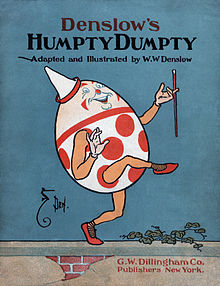| "Humpty Dumpty" | |
|---|---|
 Illustration by W. W. Denslow, 1904 | |
| Nursery rhyme | |
| Published | 1797 |
Humpty Dumpty is a character in an English nursery rhyme, probably originally a riddle and one of the best known in the English-speaking world. He is typically portrayed as an anthropomorphic egg, though he is not explicitly described as such. The first recorded versions of the rhyme date from late eighteenth-century England and the tune from 1870 in James William Elliott's National Nursery Rhymes and Nursery Songs.[1] Its origins are obscure, and several theories have been advanced to suggest original meanings.
Humpty Dumpty was popularized in the United States on Broadway by actor George L. Fox in the pantomime musical Humpty Dumpty.[2] The show ran from 1868 to 1869, for a total of 483 performances.[3] As a character and literary allusion, Humpty Dumpty has appeared or been referred to in many works of literature and popular culture, particularly English author Lewis Carroll's 1871 book Through the Looking-Glass, in which he was described as an egg. The rhyme is listed in the Roud Folk Song Index as No. 13026.
- ^ Cite error: The named reference
todayifoundoutwas invoked but never defined (see the help page). - ^ Kenrick, John (2017). Musical Theatre: A History. Bloomsbury. ISBN 9781474267021. Retrieved 16 May 2020.
- ^ "Humpty Dumpty". IBDB.com. Internet Broadway Database.